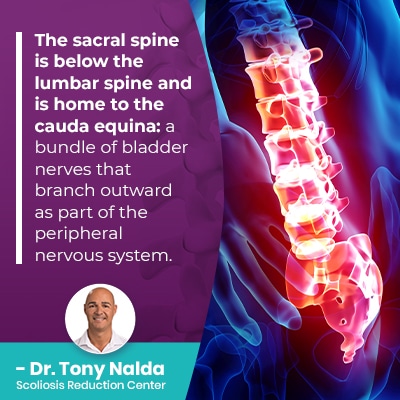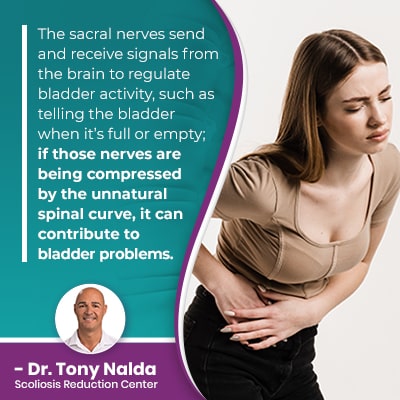Can Scoliosis Cause Urinary Problems? Is There A Link?

Scoliosis can cause a wide range of symptoms and effects felt throughout the body, including urinary problems. When scoliosis develops in the lower spine, it’s most likely to affect the bladder nerves of the sacral spine and cause urinary problems. Continue reading to learn more about scoliosis and its effects.
Scoliosis is a spinal condition that involves the development of an unnatural spinal curve that also rotates, and this exposes the spine and its surrounding muscles and nerves to uneven pressure (compression); if the bladder nerves are affected, urinary problems can develop.
Before getting to the link between scoliosis and urinary problems, let’s start by defining scoliosis and exploring some of its key characteristics.
Table of Contents
Understanding Scoliosis
It’s the spine’s natural and healthy curves that give it a soft ‘S’ shape when viewed from the sides and make it appear straight when viewed from the front and/or back; when these curves are in place, the spine’s vertebrae (bones) are aligned as they should be, but when one or more of the spine’s healthy curves are lost, it’s no longer aligned, and this will affect its strength, health, and function.
As the development of an unnatural sideways spinal cure that also rotates, scoliosis is a complex 3-dimensional spinal condition.
Scoliosis introduces a lot of uneven forces to the body, and as a progressive condition, scoliosis has it in its nature to get worse over time, and the more severe a condition is, the more likely it is to cause noticeable effects, including bladder problems.
Scoliosis ranges in severity from mild to moderate and severe to very severe, and this is also the condition’s progressive line, so where a patient’s scoliosis is at the time of diagnosis is not indicative of where it will stay.
Only proactive treatment can work towards counteracting the condition’s progressive nature, and different treatment approaches offer patients different potential outcomes, so understanding those differences is important.
As scoliosis progresses, the size of the unnatural spinal curve is increasing, and this means the condition’s uneven forces are also increasing, as are their effects.
In addition, as scoliosis progresses, the spine is becoming more rigid and less responsive to treatment, and increasing spinal rigidity can also make it difficult for patients to perform key therapeutic exercises: hence the importance of being proactive with treatment.
The link between scoliosis and urinary problems is found in how scoliosis can affect the spinal nerves, so let’s talk about scoliosis and nerve compression.
Scoliosis and Nerve Compression
There are 31 pairs of spinal nerves that make up the spinal cord, and the spinal cord and brain work in tandem to form the body’s central nervous system (CNS).
The central nervous system is a complex communication network that facilitates brain-body communication so is involved in the function of virtually every system at work within the body.
There are three main spinal sections: the cervical spine (neck), thoracic spine (middle/upper back), and the lumbar spine (lower back).
Scoliosis can develop in any of the spine’s main sections, and in most cases, the area of the body located the closest to the affected spinal section is the one most likely to feel its direct effects.
So scoliosis that develops in the lower thoracic spine and the lumbar spine, as it will mainly affect the lower body, is the type most closely associated with potential urinary problems, officially known as neurogenic bladder disorder.
 The sacral spine is below the lumbar spine and is home to the cauda equina: a bundle of bladder nerves that branch outward as part of the peripheral nervous system.
The sacral spine is below the lumbar spine and is home to the cauda equina: a bundle of bladder nerves that branch outward as part of the peripheral nervous system.
The nerves stimulate and supply bladder function/sensation, but if these nerves become compressed, inflamed, irritated and/or damaged, it can cause a number of effects, including organ dysfunction.
If an unnatural scoliotic curve of the lumbar spine has exposed the bladder nerves below to uneven pressure, they can become compressed and/or irritated and cause neurogenic bladder disorder to become an issue.
What’s Neurogenic Bladder Disorder?
Neurogenic bladder disorder (NBD) is an umbrella term that includes a range of urinary problems.
To break down the term, neurogenic refers to the nerve tissues that supply and stimulate muscles and/or organs to function properly.
If muscles and organs that play a role in bladder function are affected, issues related to bladder dysfunction can develop, and these types of issues can include:
- Loss of bladder control
- Feeling a sudden urge to urinate
- Involuntary urination
- Inability of the bladder to empty fully
- Pressure build ups causing accidental leakage
- Urinary incontinence
When neurogenic bladder disorder is an issue, the nerves that control the bladder and muscles that are used during the urination process are affected, and they cause the bladder to either become under- or overactive.
Scoliosis and Neurogenic Bladder Disorder
Part of the reason scoliosis is so often described as a complex condition to treat is because there are multiple patient/condition variables that differ from patient to patient, making no two cases the same; symptoms and effects one patient experiences aren’t necessarily indicative of what others will face, urinary issues included.
As mentioned earlier, scoliosis ranges from mild to very severe, and the more severe a condition is, and/or the longer it’s left untreated, the more likely it is to affect the body in multiple ways.
If scoliosis develops along the lower thoracic spine and/or the lumbar spine, it’s the closest to the cauda equina nerves so is the most likely to compress the sacral spine’s nerves.
 The sacral nerves send and receive signals from the brain to regular bladder activity, such as telling the bladder when it is full or empty; if these nerves are being compressed by the unnatural spinal curve, it can contribute to bladder problems.
The sacral nerves send and receive signals from the brain to regular bladder activity, such as telling the bladder when it is full or empty; if these nerves are being compressed by the unnatural spinal curve, it can contribute to bladder problems.
It should be noted, however, that although we understand how scoliosis affects nerves and can cause them to become compressed, the connection between scoliosis and neurogenic bladder disorder isn’t something that everyone experiences.
In one study, the connection between pelvic floor issues in females with thoracic and lumbar scoliosis was explored, and the study revealed that although there is a logical connection between nerve compression caused by scoliosis and the function of the bladder nerves, there isn’t a lot of evidence to support a strong association between the two.
It’s been suggested that this is because scoliosis is more closely connected to the function of the central nervous system, not the peripheral nervous system, which the urinary system is more reliant upon.
However, as the peripheral nervous system nerves do extend from the central nervous system, there is likely to be a connection between scoliosis and the bladder nerves, even if it’s more indirect, than direct.
There are also different types of scoliosis from idiopathic scoliosis, which are typical cases, to neuromuscular scoliosis that’s caused by the presence of a larger neuromuscular condition.
In cases of neuromuscular scoliosis, there is a higher likelihood that neurogenic bladder disorder could develop, but as the scoliosis is more of a secondary complication of a larger neuromuscular condition, that connection could be more related to the neuromuscular condition than the scoliosis itself.
Conclusion
So can scoliosis cause urinary problems? Yes, it can, but isn’t guaranteed to do so, and the link between scoliosis and neurogenic bladder disorder could be more indirect, than direct.
As the bladder nerves of the cauda equina start just under the first vertebrae of the lumbar spine, scoliosis that develops in the lower half of the spine is the most likely to affect the lower body, and be linked to urinary problems.
Nerves supply and regulate bladder function, and as scoliosis can cause nerve compression, this is the potential link between the two; however, the nerves of the spinal cord make up the central nervous system, while the bladder nerves that exit the sacrum branch into the peripheral nervous system, and this is why the link might be considered more indirect, than direct.
The more severe a condition is, and/or the longer it’s left untreated, the more likely it is to cause noticeable effects and complications such as urinary issues.
Remember, as a progressive condition, scoliosis is virtually guaranteed to get worse at some point, so even if a patient doesn’t initially experience urinary problems related to their condition, it doesn’t mean they won’t in the future, particularly if left untreated.
Here at the Scoliosis Reduction Center, I want to help patients avoid increasing condition effects and potential complications by proactively working towards preventing progression.
While there are no treatment guarantees, scoliosis that’s detected and treated early in the condition’s progressive line is simpler to treat and more likely to respond.
Dr. Tony Nalda
DOCTOR OF CHIROPRACTIC
After receiving an undergraduate degree in psychology and his Doctorate of Chiropractic from Life University, Dr. Nalda settled in Celebration, Florida and proceeded to build one of Central Florida’s most successful chiropractic clinics.
His experience with patients suffering from scoliosis, and the confusion and frustration they faced, led him to seek a specialty in scoliosis care. In 2006 he completed his Intensive Care Certification from CLEAR Institute, a leading scoliosis educational and certification center.
About Dr. Tony Nalda
 Ready to explore scoliosis treatment? Contact Us Now
Ready to explore scoliosis treatment? Contact Us Now





